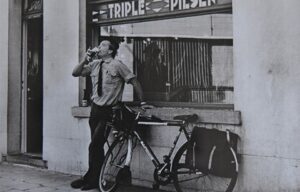-
![]() WSET® Certificering
WSET® Certificering -
![]() Keuze uit klassikaal en/of online
Keuze uit klassikaal en/of online -
![]() Persoonlijke aanpak
Persoonlijke aanpak -
![]() LifeLong Learning
LifeLong Learning -
![]() Ook in uw bedrijf
Ook in uw bedrijf
Voorafgaand aan de Australische wijnmasterclass en free-pour proeverij in Gent op 3 juni spraken we met Emma Symington MW van Wine Australia.
Emma Symington MW werkt al bijna 20 jaar in de wijnsector, met eerdere functies in zowel de verkoop als inkoop van wijn. Ze is momenteel Hoofd Educatie voor het VK en Europa bij Wine Australia. In die rol organiseert en leidt ze proeverijen, seminars en masterclasses om de kennis en het enthousiasme voor Australische wijnen en wijnregio’s te vergroten.
 U werkt al meer dan tien jaar voor Wine Australia. Wat vindt u zo boeiend aan Australische wijn, en doet u nog steeds nieuwe ontdekkingen?
U werkt al meer dan tien jaar voor Wine Australia. Wat vindt u zo boeiend aan Australische wijn, en doet u nog steeds nieuwe ontdekkingen?
Ik werk inmiddels 13 jaar voor Wine Australia en heb in die tijd verschillende wijnregio’s in Australië bezocht, met talloze wijnmakers en wijnbouwers gesproken en ontelbare wijnen geproefd – maar er valt nog steeds zoveel te ontdekken. Met 65 verschillende wijnregio’s en meer dan 150 aangeplante druivenrassen, van Assyrtiko tot Zweigelt, is er altijd wel iets nieuws te leren. Doordat er geen strikte wetgeving is over welke druiven waar geplant mogen worden, zijn Australische wijnmakers een eclectische en innovatieve groep. Ze zijn voortdurend bezig zichzelf te verbeteren, staan open voor vernieuwing en zijn niet bang om te experimenteren. Hoewel ze traditie respecteren, voelen ze zich er niet door beperkt – en dát is wat Australische wijn zo spannend maakt.
Tijdens mijn laatste reis in november 2024 viel vooral de focus op terroir en wijngaarden op – of het nu ging om klassiekers zoals Hunter Valley Semillon en Barossa Valley Shiraz, of om de ‘new wave’-stijlen zoals McLaren Vale Grenache of Adelaide Hills Grüner Veltliner. Omdat grote delen van Australië vrij zijn van phylloxera, is de gezondheid van de wijnstokken en wijngaarden essentieel. Het behoud van die status is dan ook van groot belang – zeker als je bedenkt dat sommige van de oudste wijnstokken ter wereld in Australië staan.
Tijdens de masterclass gaan we dieper in op deze oude wijnstokken en klassieke stijlen. En tijdens de free-pour tasting kun je ook kennismaken met ‘new wave’-wijnen en alternatieve druivenrassen zoals Chenin Blanc, Marsanne en Touriga Nacional.
Chardonnay uit regio’s zoals Margaret River en Yarra Valley kan zich tegenwoordig meten met de beste wijnen ter wereld. Welke technieken gebruiken Australische wijnmakers om elegantie en complexiteit te bereiken?

Australische Chardonnay verwierf aanvankelijk bekendheid met rijke, houtgelagerde wijnen boordevol smaak en rijp fruit. Maar tegenwoordig is er een nieuwe generatie Chardonnay: fris, elegant en met een duidelijk regionaal karakter. De zoektocht naar verfijning en frisheid heeft producenten naar koelere klimaatzones geleid en wijnmakers aangespoord om te experimenteren met diverse technieken.
Koelere wijnregio’s zijn onder andere Tasmanië, West-Australië (Great Southern, Geographe), Victoria (Yarra Valley, Gippsland, Mornington Peninsula), Zuid-Australië (Adelaide Hills) en New South Wales (Canberra District, Orange, Tumbarumba). Zowel in de wijngaard als in de kelder zijn technieken geëvolueerd: handmatige oogst, vroeger plukken, subtieler gebruik van eikenhout (zoals oudere en grotere Franse eiken vaten), minimale interventie en spontane vergisting zijn enkele van de methodes die het gezicht van Australische Chardonnay veranderen.
Tijdens de masterclass kunnen gasten Chardonnay proeven van iconische wijnhuizen, innovatieve producenten en koelere klimaatregio’s.
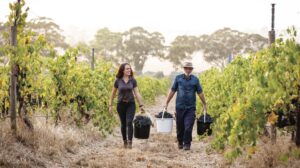
In de line-up zit ook een Chardonnay van de Anvers Estate Vineyard in Adelaide Hills. De wijn draagt de naam Anvers omdat de eigenaars van het wijnhuis, Wayne en Myriam Keoghan, elkaar daar hebben ontmoet – in Antwerpen, België.
Meer over Chardonnay ontdek je in onze Australian Wine Discovered-gids via https://www.wineaustralia.com/education/chardonnay.
Australische Shiraz heeft een enorme ontwikkeling doorgemaakt – van krachtige, hoogalcoholische stijlen naar meer verfijnde, terroirgerichte expressies. Hoe zou jij de moderne Australische Shiraz omschrijven?
Australische Shiraz kent vele verschijningsvormen – van krachtige BBQ-rode wijnen tot iconische, elegante kwaliteitswijnen. Warme klimaten zorgen meestal voor volle, rijk gearomatiseerde en gestructureerde wijnen, terwijl koelere klimaten vaak zorgen voor medium-bodied en kruidige stijlen. Van rebels tot verfijnd, klassiek tot modern, er is voor iedereen een stijl Australische Shiraz. Moderne Australische Shiraz draait om diversiteit.
Sommige van de meest elegante en parfumrijke Shiraz-stijlen komen uit regio’s met koele nachten en grote temperatuurverschillen tussen dag en nacht. Vaak met minder houtgebruik, zijn deze frisse en toegankelijke stijlen soms gelabeld als Syrah – zoals de ‘Where’s The Pope’ McLaren Vale Syrah van Ochota Barrels, die we tijdens de masterclass zullen presenteren. Meer over Shiraz ontdek je in onze Australian Wine Discovered-gids via https://www.wineaustralia.com/education/shiraz-and-blends.
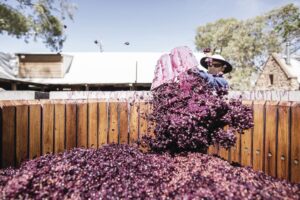 Duurzaamheid is een belangrijk verkoopargument in België. Wat doet Wine Australia samen met Australische producenten op dit gebied?
Duurzaamheid is een belangrijk verkoopargument in België. Wat doet Wine Australia samen met Australische producenten op dit gebied?
Duurzaamheid is van groot belang in de hele sector. Wine Australia werkt samen met het Australian Wine Research Institute en Australian Grape & Wine aan het nationale programma Sustainable Winegrowing Australia. Dit programma meet en rapporteert duurzame praktijken en stimuleert het gebruik van de beste methoden in wijngaarden en wijnmakerijen.
Australische producenten zijn voortdurend op zoek naar nieuwe manieren om duurzaamheid in wijngaarden en wijnmakerijen te verbeteren, bijvoorbeeld door het inzetten van geiten en bodembedekkers, het installeren van bodemvochtigheidssensoren en zonnepanelen, en het gebruik van lichtere flessen en alternatieve verpakkingen. Meer informatie over Sustainable Winegrowing Australia, casestudy’s van producenten en het Impact Report vind je op https://sustainablewinegrowing.com.au/.
Door het delen van het Impact Report, het aanmoedigen van wijnhuizen om het Sustainable Winegrowing Australia-keurmerk op hun flessen te plaatsen en het vermelden van gecertificeerde wijnhuizen tijdens onze evenementen, kunnen detaillisten en consumenten duurzaam geproduceerde wijnen herkennen en zo bijdragen aan een beter milieu.
Werk je in de horeca of wijnhandel? Dan kun je je gratis inschrijven voor een van de masterclasses. Andere geïnteresseerden zijn welkom bij de free-pour proeverij.
Download hier alvast het overzicht van de wijnen.
Inschrijven kan hier: WINE AUSTRALIA – 3/06/25 – GENT
In al je wijnenthousiasme ben je waarschijnlijk uit het oog verloren dat België het ultieme bierland is. Na water en thee is bier de meest gedronken drank ter wereld. En ons driehoekje aan de Noordzee is het schuimend en bruisend epicenter.
Ons land heeft een reputatie hoog te houden. Tot in de verste uithoeken van de zes continenten worden naam en faam van het Belgisch bier geprezen. België wordt door bierliefhebbers beschouwd als hét “bierparadijs” bij uitstek. Vraag een willekeurige toerist naar de typische kenmerken van België, en je zult horen over Brugge, onze verfijnde chocolade, de Rode Duivels of sinds kort eerder Nafi Thiam en Remco 🙂 en natuurlijk: ons bier. Maar bestaat er wel zoiets als ‘Belgisch bier’? En mag België zich werkelijk het predicaat “werelds beste bierland” toe-eigenen? Ja, echter is het antwoord genuanceerder dan dat. Om de Belgische biercultuur te begrijpen moeten we verschillende geografische, historische, religieuze, politieke en wettelijke aspecten in kaart brengen.
De biergordel 
België behoort tot de zogenaamde “biergordel”, een brede strook die Europa van oost naar west doorkruist. Ons land beschikt over de nodige grondstoffen, zoals gerst en hop, om bier te produceren. Bovendien zijn sommige streken bekend om hun uitstekende waterkwaliteit. Zo is Spa een generiek begrip in de wereld van mineraalwater en wellnesscentra, dankzij de beroemde bronnen in het Waalse stadje Spa.
Door de eeuwen heen is België constant bezet geweest door verschillende buitenlandse mogendheden: Romeinen, Franken, Fransen, Spanjaarden, Oostenrijkers, Duitsers… en ja, zelfs de ‘Hollanders’ hebben in onze gewesten de plak gezwaaid. Onze reactie hierop was tweezijdig: enerzijds namen we de goede elementen over en integreerden deze invloeden in onze (bier)cultuur. Anderzijds bleven we koppig vasthouden aan onze (bier)tradities om onze eigenheid te bewaren. Sommige historici zien bierdrinken zelfs als een vorm van verzet, al willen we daar niet te ver in gaan.
Trappistenbier
 Zes van de tien Trappistenbrouwerijen (Achel, Chimay, Orval, Rochefort, Westmalle, en Westvleteren) bevinden zich op Belgisch grondgebied. Dit is geen toeval. Het katholieke België was eeuwenlang een veilig toevluchtsoord voor religieuzen die in hun thuisland vervolgd werden. Onze noordelijke (Nederland) en oostelijke buren (Duitsland) omarmden het protestantisme, terwijl in het roerige Frankrijk de kerk vaak het mikpunt van kritiek was. Veel monniken vonden een tweede thuis in onze contreien. Aangezien bier de volksdrank bij uitstek was, legden deze nieuwkomers zich toe op het brouwambacht—tot ons groot jolijt. Overigens bevinden de twee Nederlandse Trappistenbrouwerijen zich op een steenworp afstand van de Belgische grens.
Zes van de tien Trappistenbrouwerijen (Achel, Chimay, Orval, Rochefort, Westmalle, en Westvleteren) bevinden zich op Belgisch grondgebied. Dit is geen toeval. Het katholieke België was eeuwenlang een veilig toevluchtsoord voor religieuzen die in hun thuisland vervolgd werden. Onze noordelijke (Nederland) en oostelijke buren (Duitsland) omarmden het protestantisme, terwijl in het roerige Frankrijk de kerk vaak het mikpunt van kritiek was. Veel monniken vonden een tweede thuis in onze contreien. Aangezien bier de volksdrank bij uitstek was, legden deze nieuwkomers zich toe op het brouwambacht—tot ons groot jolijt. Overigens bevinden de twee Nederlandse Trappistenbrouwerijen zich op een steenworp afstand van de Belgische grens.
De Invloed van Politiek en Wetgeving
Zoals altijd speelt de politiek een rol. Elk dorp van enige omvang telde minstens twee brouwerijen: één met een katholieke signatuur en één met een liberale of socialistische achtergrond. Het trakteren van “pinten” bleek een krachtig wapen in verkiezingscampagnes. In veel gevallen was de brouwer ook de burgemeester. Een goede traditie, als je het mij vraagt—vers, hoppig bier in plaats van politieke boodschappen die de verzuring in de hand werken.
Van politiek naar overheidsingrijpen is meestal slechts een kleine stap. De Wet Vandervelde uit 1919 verbood het schenken van sterke drank in cafés. De situatie was schrijnend: arbeiders werden na een lange werkweek uitbetaald in de lokale kroeg, die vaak eigendom was van de patroon. Moegewerkte mannen met geld op zak in een kroeg vol vrienden vormden een explosieve cocktail. Het gevolg: dronken mannen die zonder geld naar huis keerden, hun vrouwen mishandelden, en hun gezinnen in de ellende stortten. De wet moest deze situatie aanpakken en alcoholisme onder de verarmde bevolking tegengaan.
De brouwers zagen hun kans schoon en brachten bieren met een hoger alcoholvolume op de markt. Enkele grote klassiekers, zoals Duvel, Westmalle Tripel, en Bush van Dubuisson, zagen in deze periode het levenslicht. Hoewel de Wet Vandervelde uiteindelijk een slag in het water bleek, danken we toch enkele uitstekende bieren aan dit overheidsingrijpen.
Belgische Brouwers: Vrijheid en Creativiteit
In vergelijking met hun Duitse en Engelse collega’s genoten onze brouwers relatief veel vrijheid. Duitse brouwers zaten gevangen in het keurslijf van het Reinheitsgebot (waarbij alleen hop, water, mout, en gist gebruikt mochten worden). Dit gebod werd pas gedeeltelijk afgeschaft in 1987 onder druk van de EU. Engelse brouwers zuchtten onder het juk van hoge accijnzen op alcohol. Premier Gladstone baseerde vanaf 1880 de accijnzen op de sterkte van het bier in plaats van op de mout. Het gevolg was dat laag-alcoholische bieren de overhand kregen in het Engelse bierlandschap.
Neem al deze elementen bij elkaar, en de basis is gelegd voor een bloeiend bierlandschap. Kleuren, geuren, smaken—België kan bogen op een enorm bieraanbod, voortkomend uit de ‘savoir-faire,’ de passie, en de nooit aflatende creativiteit van onze brouwers. Dankzij onze rijke geschiedenis regeert koning bier in België.
WineWise biedt sinds kort ook de gloednieuwe WSET Beer opleidingen aan. Om de inhoudelijke kwaliteit te garanderen werken we hiervoor samen met bierspecialist Luc De Raedemaeker. Hij vervoegde ons WineWise Trainers team en zal de bieropleidingen geven.
Ontdek zelf de rijke wereld van bier en word een echte bierexpert!
Schrijf je in voor de WineWise WSET-opleiding Bier en leer alles over de unieke smaken, stijlen en tradities van bier.
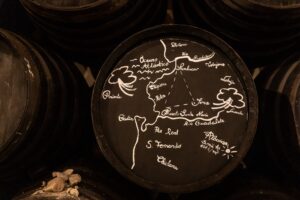 Als je vraagt welke wijnregio’s wereldwijd het meest ondergewaardeerd worden, zet ik Jerez zonder twijfel in mijn top vijf. Sherry’s zijn geen makkelijke doordrinkwijnen, en hun reputatie als een zondags aperitief voor zorgvuldig gekapte oudere dames blijft jammer genoeg wat hangen. Nochtans heeft sherry zoveel meer te bieden dan de eenvoudige fino’s uit veel cafés en restaurants, waar de fles vaak al wekenlang openstond, in afwachting van een zeldzame liefhebber.
Als je vraagt welke wijnregio’s wereldwijd het meest ondergewaardeerd worden, zet ik Jerez zonder twijfel in mijn top vijf. Sherry’s zijn geen makkelijke doordrinkwijnen, en hun reputatie als een zondags aperitief voor zorgvuldig gekapte oudere dames blijft jammer genoeg wat hangen. Nochtans heeft sherry zoveel meer te bieden dan de eenvoudige fino’s uit veel cafés en restaurants, waar de fles vaak al wekenlang openstond, in afwachting van een zeldzame liefhebber.
Anno 2023 richten de producenten in Jerez zich steeds meer op kwaliteit dan kwantiteit, en wij als consument kunnen een spannende collectie van erg diverse stijlen leren kennen – net als hun potentieel en veelzijdigheid aan tafel.
Copa Jerez 2023
Dat laatste werd enkele weken geleden nog maar eens bevestigd, tijdens wat ondertussen de hoogdagen van de sherrygebaseerde gastronomie geworden zijn: de Copa Jerez. Nadat Fabian Bail en Paul-Henri Cuvelier van restaurant Paul de Pierre in 2021 met de drie hoofdprijzen naar huis kwamen (Beste Chef, Beste Sommelier and Beste Pairings), kan ik me voorstellen dat het veel moed vergde van de nieuwe lichting om zich in te schrijven voor de Belgische preselectie van dit jaar. Maar gelukkig durfden verschillende dapperen het aan, en onder hen werden Chef Arnout Desmedt en Sommelier Gianluca Di Taranto van A Cook & GDT geselecteerd om België te vertegenwoordigen op de 20ste editie van de Copa Jerez. De magie die we proefden bij de Belgische finale, hebben ze in Jerez ook kunnen overbrengen aan de indrukwekkende vijfkoppige jury, met Jancis Robinson (Master of Wine & wijn journalist), Almudena Alberca (Master of Wine & wijnmaker), Melania Bellesini (sommelier van The Fat Duck***), Pascaline Lepeltier (schrijfster & Beste Sommelier van Frankrijk 2018) en Josep Roca (sommelier & mede-eigenaar van El Celler de Can Roca***).
Het leverde hun een indrukwekkende tweede plaats op, en Gianluca mocht daarbovenop de award voor ‘Juli Soler Award for Best Sommelier’ mee naar België nemen.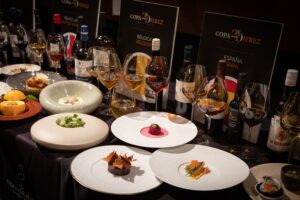
Hun voorgerecht op basis van artisjok, in combinatie met de Fino Inocente van Bodegas Valdespino, vonden we allemaal schitterend. Het werd gevolgd door een moedig plantaardig hoofdgerecht ‘rijst met wintergroenten’, waarbij Gianluca de Manzanilla Pasada La Bota 103 van Equipo Navazos serveerde. En de knipoog naar België-Spanje werd doorgetrokken tot in het dessert: een speelse variant op crêpe suzette, maar dan zonder de crêpe, met cox appelen én geserveerd in een sinaasappel, gecombineerd met een topper binnen de cream sherry’s: Cream Tradición VOS van Bodegas Tradición.
Jerez – oud en nieuw
Om een wijnregio beter te begrijpen, vind ik het belangrijk om enerzijds de lokale wijnen en gerechten te proeven, maar daarnaast ook in de wijngaarden zelf te wandelen, de lucht op te snuiven, de bodems onder je voeten te voelen, en de weersinvloeden aan den lijve te ondervinden. Gelukkig kregen we daar op deze trip ook ruimschoots de kans toe.
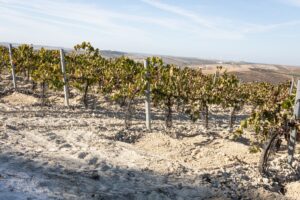 Zo deden de grijsgroene landschappen, met wijnstokken bestoven door de albarizobodems, me beter begrijpen waarom het hier zo belangrijk is om de most goed te klaren voor de gisting. En eens je de harde witte korst van albarizo hebt horen en voelen kraken onder je voeten, begrijp je beter hoe de wijnstokken de droge zomers kunnen overleven, maar ook waarom de wijnbouwers na de oogst de aserpiatechniek toepassen in de wijngaard, waarbij tussen de rijen troggen gegraven worden, die het regenwater in de herfst en de winter opvangen, zodat het insijpelt in de bodem in plaats van weg te stromen en de bodem verder te eroderen.
Zo deden de grijsgroene landschappen, met wijnstokken bestoven door de albarizobodems, me beter begrijpen waarom het hier zo belangrijk is om de most goed te klaren voor de gisting. En eens je de harde witte korst van albarizo hebt horen en voelen kraken onder je voeten, begrijp je beter hoe de wijnstokken de droge zomers kunnen overleven, maar ook waarom de wijnbouwers na de oogst de aserpiatechniek toepassen in de wijngaard, waarbij tussen de rijen troggen gegraven worden, die het regenwater in de herfst en de winter opvangen, zodat het insijpelt in de bodem in plaats van weg te stromen en de bodem verder te eroderen.
Tenslotte, dankzij de spirituele ervaring van een bezoek aan de wijnkathedralen in de bodegas, waar eindeloze rijen vaten gestapeld liggen en de lucht doordrongen is van gistige, notige, curry-achtige aromas en beneveld kelderstof, begrijp ik nu pas echt wat een uniek erfgoed hier rijpt voor het nageslacht. 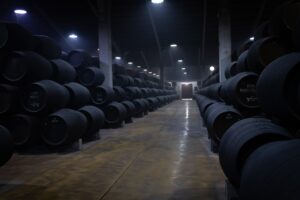 Het versterkte voor mij het besef hoe belangrijk het is voor deze regio om zich te blijven richten op kwalitieve wijnen, maar tegellijk om mee te evolueren met de tijd, zodat Jerez ook een mooie, lange en economisch rendabele toekomst voor zich heeft.
Het versterkte voor mij het besef hoe belangrijk het is voor deze regio om zich te blijven richten op kwalitieve wijnen, maar tegellijk om mee te evolueren met de tijd, zodat Jerez ook een mooie, lange en economisch rendabele toekomst voor zich heeft.
En Jerez is duidelijk in evolutie, met onder meer een stijgend aantal producenten die zich bewust richten op kwaliteit en karakter, en boeiende ontwikkelingen op het gebied van niet-versterkte wijnen.
In tegenstelling tot wat we misschien denken, zijn niet-versterkte wijnen geen nieuw fenomeen in Jerez, maar maken ze deel uit van de geschiedenis van de regio. Enerzijds waren er traditioneel de zogenaamde ‘vinos de pasto’ of ‘wijnen van de graslanden’, de naam die gegeven werd aan de typische maaltijdwijnen uit de regio, die gemaakt werden voor plaatselijke consumptie. Maar daarnaast zijn er veel historische verwijzingen naar sherry-achtige wijnen, die een hoog alcoholpercentage bereikten doordat de druiven laat geoogst werden en/of gedroogd in de zon, wat soleo of asoleo genoemd wordt. Dit zou gangbaar geweest zijn, vooraleer in de 17e en 18e eeuw het versterken van wijn de overhand nam om de wijnen te stabiliseren voor de lange bootreizen naar buitenlandse markten. In de D.O. Montilla-Moriles zijn niet-versterkte sherrywijnen trouwens vrij courant, dus ga daar zeker eens op zoek naar een niet-versterkte fino van PX-druiven – die zijn vaak wat voller, zachter en fruitiger dan fino sherry’s, interessant, en niet duur.
Ook in Jerez hebben niet-versterkte sherry’s in de voorbije vijftien jaar aan belang gewonnen, en dit is nu vertaald in de nieuwe regelgeving van de D.O. Jerez. Sinds oktober 2022 moeten sherrywijnen niet langer verplicht versterkt zijn, op voorwaarde dat ze toch het minimaal vereiste alcoholpercentage bereiken (15% voor fino en manzanilla). De overige regels, zoals biologische opvoeding onder flor, en een veroudering van minimum twee jaar, moeten uiteraard gerespecteerd worden.
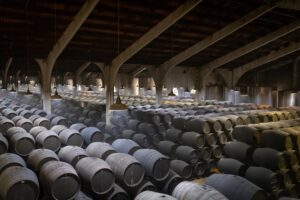 Interessant is ook dat in de nieuwe regelgeving, een aantal traditionele inheemse druivenvariëteiten zoals beba, perruno en vigiriega, ook toegelaten worden binnen de D.O. En de Zona de Crianza werd uitgebreid en loopt nu gelijk met de Zona de Producción of Marco de Jerez, de ruimere regio waar de druiven geteeld worden. Dit wil zeggen dat sherry nu niet langer opgevoed moet worden in de ‘sherrydriehoek’ van Jerez de la Frontera, El Puerto de Santa María en Sanlúcar de Barrameda, en de bodegas in de omringende gemeenten, zoals Chipiona en Chiclana, kunnen hun wijnen nu zelf verouderen en op de markt brengen onder de D.O. Jerez.
Interessant is ook dat in de nieuwe regelgeving, een aantal traditionele inheemse druivenvariëteiten zoals beba, perruno en vigiriega, ook toegelaten worden binnen de D.O. En de Zona de Crianza werd uitgebreid en loopt nu gelijk met de Zona de Producción of Marco de Jerez, de ruimere regio waar de druiven geteeld worden. Dit wil zeggen dat sherry nu niet langer opgevoed moet worden in de ‘sherrydriehoek’ van Jerez de la Frontera, El Puerto de Santa María en Sanlúcar de Barrameda, en de bodegas in de omringende gemeenten, zoals Chipiona en Chiclana, kunnen hun wijnen nu zelf verouderen en op de markt brengen onder de D.O. Jerez.
Zonder twijfel erg interessante ontwikkelingen, in een regio geassocieerd met lange tradities en erg specifieke productietechnieken. Hoe dit verder zal evolueren, en hoe de veranderingen door wijnconsumenten en -professionelen zullen onthaald worden, valt niet te voorspellen. Maar één ding is zeker: de Consejo Regulador en de sherryproducenten hebben de nodige uitdagingen voor de boeg. Aan hen de taak om sherry een nieuw tijdperk en veranderende markten in te loodsen, waar ze de verschillende stijlen van sherry kunnen profileren als uitstekende maaltijdwijnen, die voor boeiende pairings kunnen zorgen met ingrediënten en kookstijlen van over de ganse wereld. En dit alles terwijl ze de kwaliteit blijven verhogen en onderhouden. Bovendien zullen ze ook een passende naam moeten vinden voor de steeds populairdere niet-versterkte stille wijnen uit Jerez. Want die hebben veel hogere kwaliteitsambities en meer gastronomisch potentieel dan hun huidige officieuze benaming ‘vino de pasto’ doet vermoeden. Suggesties? Stuur maar door …
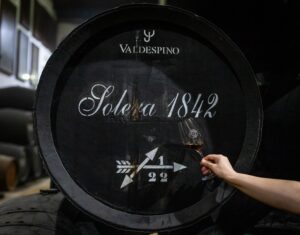 In de tussentijd, terwijl de dagen hier terug korter en killer worden, is er weinig dat zo troostend werkt voor lichaam en geest, dan een warm en gezellig moment, in goed gezelschap, met een glas van je favoriete sherry in de hand. Salud, op een heerlijke herfst en een hartverwarmende winter!
In de tussentijd, terwijl de dagen hier terug korter en killer worden, is er weinig dat zo troostend werkt voor lichaam en geest, dan een warm en gezellig moment, in goed gezelschap, met een glas van je favoriete sherry in de hand. Salud, op een heerlijke herfst en een hartverwarmende winter!
In het laatste deel van de D6 paper over duurzaamheid, vroeg WSET om de link te leggen naar de consumenten: hebben ze baat bij duurzaamheid, en in welke mate beïnvloedt het hun gedrag?
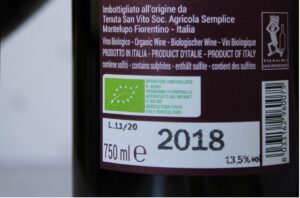 Heeft de consument baat bij duurzaamheid?
Heeft de consument baat bij duurzaamheid?
Echte duurzaamheid zou moeten voordelen inhouden voor consumenten, omdat het een evenwicht nastreeft tussen de belangen van mensen, de planeet, en economisch profijt. Het beïnvloedt de lucht die we ademen; het water – en de wijn – die we drinken; het leven dat we leiden en de hulpbronnen die daarvoor ter beschikking zijn, voor ons zowel als voor onze nakomelingen.
Economische groei heeft veel voordelen gebracht, van het reduceren van armoede tot de verbetering van mensenrechten en toegang tot onderwijs, gezondheidszorg, water en sanitaire voorzieningen. Maar onze ‘nu groeien, later opruimen’-mentaliteit, in de woorden van duurzaamheidsonderzoekers Paul Ekins & Dimitri Zenghelis, heeft lang geen rekening gehouden met zogenaamde externaliteiten, de niet gecompenseerde kosten of schade als gevolg van economische activiteiten. Ze beschrijven het nogal dramatisch: ‘deze aanpak heeft de menselijke samenleving op de rand van de afgrond gebracht, waardoor al deze voordelen en zelfs het voortbestaan van de beschaving ernstig in gevaar zijn gebracht’.
We kunnen zeker stellen dat maatregelen die ons toelaten om de menselijke beschaving, business, handel en de productie van eten en drinken te continueren, goed zijn voor de consument. Maar op korte termijn kunnen die maatregelen ervoor zorgen dat prijzen stijgen om de effectieve, volledige kost van een product te reflecteren. Om economisch duurzaam te zijn moeten prijzen ook die kosten incalculeren die voordien doorgeschoven werden naar andere partijen of toekomstige generaties. Ondanks het feit dat consumenten prijsstijgingen niet ervaren als een voordeel, leggen faire prijzen toch de basis voor een blijvende, duurzame productie en consumptie, en kunnen ze een stimulans vormen voor het efficiënt aanpakken en oplossen van problemen.
Een bijkomend, minder voor de hand liggend voordeel is dat succesverhalen over duurzaamheid ons hoop geven. In deze tijden van negatief nieuws kunnen verbeteringen in milieu-, sociale en economische indicatoren ons motiveren om verder te gaan. Eén van mijn absoluut favoriete wetenschappers, professor Hans Rosling, noemde dit ‘factfulness’: begrijpen als bron voor mentale rust. Hij waarschuwde tegen het verlies van hoop: ‘wanneer mensen verkeerdelijk aannemen dat dingen niet verbeteren, kunnen ze tot de conclusie komen dat niets dat we al hebben geprobeerd, heeft gewerkt, en het vertrouwen verliezen in maatregelen die wel werken.’
Heeft duurzaamheid een invloed op consumentengedrag?
Onderzoek door Wine Intelligence bracht aan het licht dat wijnconsumenten geven om personalisatie, ervaringen, gemak en duurzaamheid. Duurzaam geproduceerde wijnen aligneren met ‘ethische consumptie’, en consumenten zien ze als innovatief, trendy en beter voor de gezondheid.
Daarentegen staat dat het gedrag van consumenten niet meteen consequent is met deze positieve associaties, en dat slechts weinig mensen die duurzaamheid een goeie zaak vinden, ook duurzame producten aankopen. Dit fenomeen staat gekend als ‘de groene kloof’, of in het Engels: the green attitude-behaviour gap of green purchasing inconsistency.
In een webinar van het Institute of Masters of Wine verklaart onderzoeker Juan Park dit door hoe onze hersenen het aangeboren pijn- en beloningssysteem gebruiken voor aankoopbeslissingen. Wanneer we een aanschaf overwegen, evalueert ons brein welke voordelen we eruit halen, tegen wat het ons zal kosten. Als de verwachte beloning zwaarder doorweegt dan de pijn, zijn we geneigd om te kopen.
Onder de wijnconsumenten die door Wine Intelligence bevraagd werden, maakte 55% zich zorgen over het klimaat. Maar slechts 40% waren bereid om meer ‘pijn’ te verdragen – in de vorm van meer inspanning doen of een hogere prijs betalen – voor duurzame wijnen. Tegelijkertijd, wanneer een product past bij hun zelfbeeld en overtuigingen, of ze het associëren met hogere standaarden en betere kwaliteit (= grotere beloningen), zijn consumenten geneigd om het aan te schaffen.
Wijntermen zoals ‘natuurwijn’, ‘biologisch’, ‘milieuvriendelijk’, ‘duurzaam geproduceerd’, ‘zonder bewaarmiddelen’ of ‘fair-trade’ verhogen de aankoopbereidheid. Daarentegen, bij claims die consumenten verwarren, zoals ‘sulfietvrij’, ‘CO2-neutraal’, ‘biodynamisch’ of ‘veganistisch’, werd het tegenovergestelde effect aangetoond.
Dit suggereert allemaal dat consumenten effectief geven om duurzaamheid, en erdoor beïnvloed worden, op voorwaarde dat de beloning duidelijk is. Een Italiaanse studie bevestigde dat reacties op duurzaamheidsclaims erg heterogeen zijn, maar dat etiketten die ecologische aspecten vermelden niettemin de verkoopcijfers verhogen. Daarbovenop zijn consumenten ook bereid om meer te betalen voor wijnen van producenten die eerlijke werkomstandigheden respecteren.
Die positieve effecten van duurzaamheid op consumptiegedrag worden aangetoond in verschillende segmenten, maar het meest bij millennials, op voorwaarde dat de claims duidelijk gedefinieerd en prominent weergegeven worden. Verschillende studies tonen aan dat vooral jonge mensen met hogere inkomens, opleidingsniveaus en betere kennis van eco-certificering bereid zijn om een hogere prijs te betalen voor fair-trade en duurzaam geproduceerde wijnen. Maar voor consumenten met lagere inkomens vormen hogere prijzen duidelijk een drempel, los van hun milieubewustzijn en sociale attitudes.
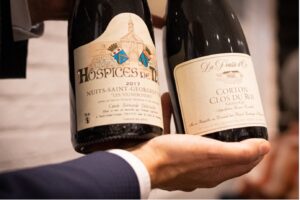 Samengevat…
Samengevat…
Wanneer wijnbedrijven hun ecologische, sociale of economische duurzaamheid willen verbeteren, is het essentieel een grondige analyse te maken van de huidige situatie, die markeert waar winsten kunnen geboekt worden. Bij beslissingen om de milieu-impact van een bedrijf te verlagen moet bovendien de volledige levenscyclus van technologieën en maatregelen in rekening gebracht worden. Door meer bewustzijn te creëren, de werkomstandigheden te verbeteren en medewerkers uit alle delen van het bedrijf bij de duurzaamheidsdoelstellingen te betrekken, werken meer handen en hersenen samen om ze te bereiken.
En tenslotte: marketing en communicatie zijn belangrijk. Duidelijke en prominent weergegeven duurzaamheidsacties en claims verhogen de aantrekkelijkheid van een wijn voor consumenten, het engagement van medewerkers en versterken het imago en de impact van een merk. Verspreid het woord aan je klanten!
Bedankt Kristel !
Dit artikel is gebaseerd op de D6 onderzoekspaper die Kristel Balcaen indiende in juli 2022. Haar (Engelstalige) paper kan je hier terugvinden. Kristel behaalde een “pass with distinction” wat zeldzaam is voor een D6 paper in de WSET Diploma cursus.
In July’s D6 paper, we were also asked to examine how wine producers can improve their social sustainability through employee relationships. Another interesting angle to truly sustainable development, and one we may not automatically consider when we hear the word ‘sustainability’.
Social sustainability deals with the identification and management of business impacts on people, both positive and negative. What companies do, directly or indirectly affects their employees, workers in the wider value chain, their customers and the local community they are embedded in.
How to improve social sustainability for wine industry employees is a complicated question, in part because social sustainability has many faces. Wine is produced on all continents but Antarctica, and circumstances in different countries, regions and layers of society are highly divergent. In areas with stable, mature economies and reliable social protection in place, the focus tends to be on wellbeing, actions to improve work-life balance and on mitigating the effects of peak-season overtime. Meanwhile, in regions where working conditions for full-time, seasonal or migrant workers are still largely unregulated, sustainability needs to address basic human rights, health and safety first.
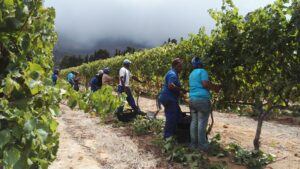 Working conditions and workers’ rights
Working conditions and workers’ rights
To illustrate this chasm: a 2020 study in Austria and Germany identified job satisfaction criteria among wine sector employees, such as remuneration, career opportunities, recognition by colleagues and managers, quality of the wines and alignment with the company’s philosophy.
In contrast, a 2021 OXFAM report revealed large-scale exploitation of immigrant workers in areas of Spain, Italy, France, Bulgaria, South America, New Zealand and South Africa, with issues ranging from excessive working hours, below-minimum wages and lack of insurance, to forced labour, abysmal housing conditions and severe health and safety hazards. International investigations even linked certain seasonal-labour agencies to organised crime groups involved in human trafficking.
But even in businesses where workers’ basic rights are fulfilled, improvements can be made. In its sustainable winery checklist, the US Pacific Northwest’s certification body LIVE states criteria for community impact, workers’ health, safety, education and benefits, from staff training and policy participation to adequate meal periods, rest breaks and availability of hygiene, sanitation and first-aid facilities. Remuneration for members must exceed legal minimum wages, with paid overtime and vacation, healthcare and retirement benefits. Equally, in South Africa, the IPW sustainability guidelines include staff training, health and safety measures.
Employability
Wineries can also launch own initiatives for a socially sustainable workplace. John Williams of Frog’s Leap in Rutherford, for example, invested in year-round employment and benefits for their immigrant workers. He involves employees in decision-making and continues to lower the spread between the lowest and highest-paid jobs. O’Neill Vintners & Distillers offer university scholarships and internships to advance the representation of black, indigenous and people of colour and ensure a well-rounded, diverse workforce. In 2011 Moët Hennessy Louis Vuitton created a sheltered workshop for disabled employees, several of which secured permanent contracts at their Champagne houses since. In Bordeaux, Château Montrose developed ergonomic tools for its workers, while Château Anthonic increases employability by teaching vineyard skills to low-skilled young workers.
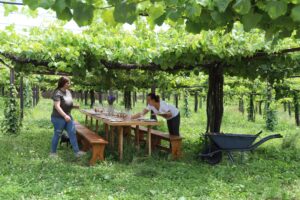 Community
Community
Social sustainability can also be improved by contributing to the local community, forging bonds with people, organisations and businesses in the region. Companies can recruit, source services or goods locally and support regional tourism and initiatives. When wine producers work constructively within their community, it raises the brand’s image and strengthens their employees’ positive feelings about the workplace. This in turn boosts employee retention, engagement, motivation, productivity and customer service.
Measures to mitigate negative impact on the community and enhancing environmental sustainability further improve employee relationships. As marketing expert Helen Wells asserts:
Better brand, happier staff. Being perceived as a green company is great for your brand image, and can make staff recruitment and retention easier. People want to work for companies that are part of the solution, rather than part of the problem.
Management
Finally, I want to stress the value of ‘enlightened management’ in employee relationships. For a business to be socially sustainable, it should not be run in fear, mistrust and micromanagement. Hiring the right persons for the job, rewarding them fairly, providing meaningful involvement and growth and training opportunities, are the ways forward. If this is actively and consistently put into practice, even staff who leave the business are likely to remain brand advocates. They can also become trusted contacts or business partners in their new capacity, which results in a strong, sustainable social network.
An example of a wine producer with such a strong socially-centred philosophy is Wirra Wirra in South Australia’s McLaren Vale. On their way to the entrance, staff and customers, referred to as the ‘Wirra Wirra tribe’, pass an installation with the words of the iconic Greg Trott, who revived the winery in the 1960s:
Never give misery an even break, nor bad wine a second sip.
You must be serious about quality, dedicated to your task in life, especially winemaking, but this should all be fun.
Continued in part 3.
This article is based on the July 2022 D6 paper Kristel submitted. Read it here.
Kristel passed this paper with distinction, a mark that few achieve for this unit within the WSET Diploma course.

